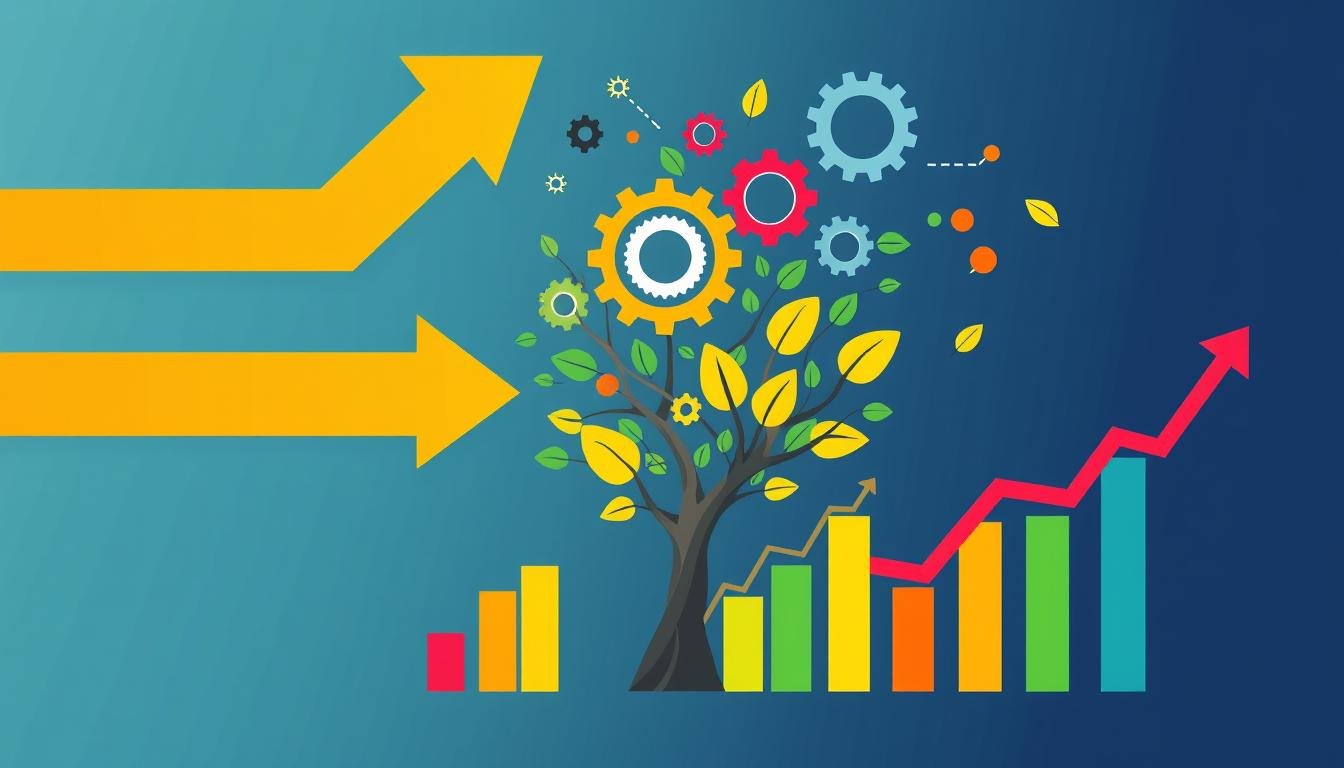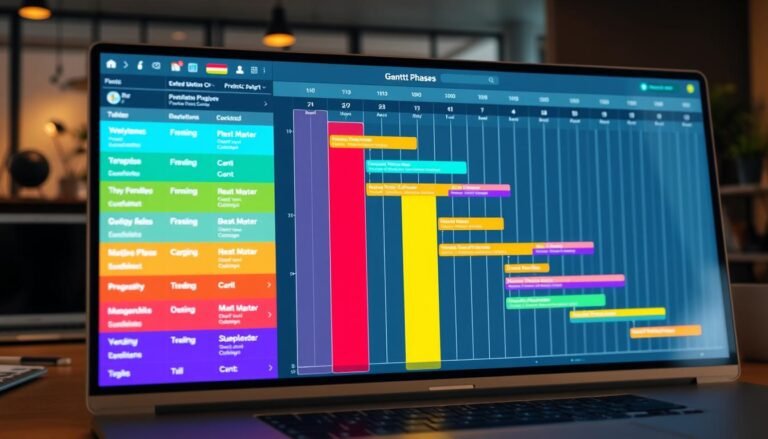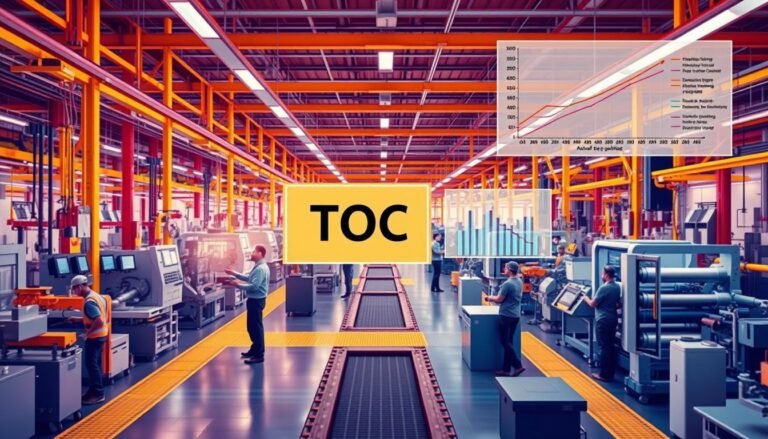Unlocking Growth: Boost Your Customer Lifetime Value
Ever wondered why some businesses do well while others don’t? It often comes down to a key metric: Customer Lifetime Value (CLV). By understanding and improving CLV, you can boost your business and keep customers coming back. In today’s market, keeping customers is key since it’s often cheaper than getting new ones. Are you ready to see how focusing on CLV can change your business for the better?
Key Takeaways
- CLV reflects the total worth of a customer over their relationship with your business.
- Retaining existing customers is generally more cost-effective than acquiring new ones.
- Fostering strong customer loyalty can lead to a higher probability of repeat sales.
- Reducing churn rates through customer engagement initiatives can boost overall profitability.
- Regularly calculating CLV helps businesses adapt strategies based on changing customer behaviors.
- Segmenting customers by CLV allows tailored approaches for various customer value categories.
Understanding Customer Lifetime Value (CLV)
Customer Lifetime Value (CLV) is key to a business’s financial health. It’s the total value a customer brings over their time with a brand. Knowing CLV helps companies plan better for getting and keeping customers. This boosts customer profitability and customer retention rates.
Definition of CLV
CLV looks at both what customers have spent and what they might spend in the future. Historic CLV adds up what customers have already spent. Predictive CLV uses data to guess future earnings. This mix gives businesses deep insights into their customers, showing which ones are most profitable.
Importance of CLV in Business Growth
CLV is very important, especially when getting new customers is getting pricier. Costs for getting customers have jumped by 222% in areas like e-commerce. Focusing on CLV helps spot when customers might leave early and act fast to keep them. By making customers happier and keeping them around, companies can grow sustainably.
| Aspect | Historic CLV | Predictive CLV |
|---|---|---|
| Definition | Measures past customer spending | Forecasts future value based on data |
| Cost of Acquisition | Actual costs incurred | Estimates projected costs |
| Use Cases | Analyze existing customers | Target new customer acquisition |
| Focus | Retention strategies | Predictive analytics for growth |
Using both historic and predictive CLV gives businesses a full picture. This approach helps in understanding and planning for the future. It shows the importance of caring for current customers. This way, companies can make more money from customer profitability and spend less on getting new ones.
Strategies to Boost Customer Lifetime Value
To boost customer lifetime value (CLV), businesses need to focus on building strong relationships with their customers. They should invest in the onboarding process, referral programs, and customer experience. This approach helps build loyalty and increases revenue.
Enhancing the Onboarding Process
A good onboarding process is key to keeping customers. Poor onboarding can lead to a 23% churn rate. By tailoring the experience to each customer, companies can keep them engaged and using their products more.
It’s important to offer support and show value right from the start. This makes customers see the worth of their investment.
Implementing Effective Referral Programs
Referral programs are great for boosting CLV. Customers brought in through referrals are 16% more valuable and churn 18% less than those from other marketing. Getting current customers to recommend the brand helps bring in new customers and builds a loyal community.
Offering rewards for referrals can make these efforts even more effective.
Creating Memorable Customer Experiences
Providing great experiences at every step is key to keeping customers happy and loyal. Brands should offer personalized interactions to make customers feel special. They should also be ready to help across different channels, as 58% of customers expect this.
Showing appreciation to loyal customers with rewards can also help keep them coming back. This approach can lead to more profits over time.
Customer-Centric Approaches for Maximizing CLV
Businesses need to focus on their customers to boost customer lifetime value (CLV). By engaging with customers and building loyalty, companies can create strong relationships. This leads to customers sticking with the brand longer.
Personalizing marketing helps make customers happier and more likely to return. This approach makes the customer’s experience better, leading to more repeat business.
Fostering Customer Engagement and Loyalty
Listening to what customers say and building a community around a brand helps a lot. Using customer advisory boards gives businesses direct feedback from important customers. This boosts loyalty.
Also, 86% of buyers say they’re willing to pay more for a better experience. This shows how crucial it is for companies to keep improving.
Utilizing Personalization in Marketing Efforts
Personalized marketing lets companies offer things that really speak to each customer. This builds stronger bonds. By using data, businesses can learn what customers like, making them more engaged.
It’s important to reward loyal customers, as they often spend a lot more than new ones. With personal touches, companies can make customers feel special. This leads to loyalty and a higher CLV.
| Strategy | Impact on CLV |
|---|---|
| Customer Feedback | Enhances brand loyalty and retention rates |
| Personalized Offers | Increases customer engagement and repeat purchases |
| Customer Advisory Boards | Fosters loyalty and advocacy among key accounts |
| Onboarding Experiences | Builds long-term relationships with customers |
| Referral Programs | Cost-effective method to attract new customers |
Measuring and Calculating Customer Lifetime Value (CLV)
Understanding how to measure CLV is key for any business looking to grow and keep customers. By using CLV calculation metrics, companies can better understand their customer relationships. This helps them make smart decisions. We’ll look at important metrics for CLV calculation and tools that help track and analyze this key metric.
Key Metrics for CLV Calculation
Several important metrics are crucial for CLV calculations. Businesses should think about these:
- Average Purchase Value: This is found by dividing Total Revenues by Total Purchases. It shows how much money an average customer spends per buy.
- Average Purchase Frequency: This is the number of buys in a set time divided by the total number of customers who bought during that time.
- Average Customer Lifespan: This tells us how long a customer keeps buying from the company. It’s key to understanding customer retention.
- Customer Lifetime Value (CLV): CLV is figured out like this: CLV = Average Order Value (AOV) x Average Purchase Frequency Rate (AFR) x Average Customer Lifespan.
| CLV Calculation Metrics | Formula | Description |
|---|---|---|
| Average Purchase Value | Total Revenues / Total Purchases | Shows revenue per buy. |
| Average Purchase Frequency | Number of Purchases / Number of Unique Customers | Looks at how often customers buy. |
| Customer Lifetime Value | AOV x AFR x Average Customer Lifespan | Estimates total revenue from a customer over time. |
Tools and Software for CLV Measurement
There are tools that make measuring CLV easier and more precise. Businesses can use these tools for customer lifetime value analysis. Some top tools include:
- CRM Software: Tools like HubSpot and Salesforce help track customer interactions and calculate CLV from the data.
- Analytics Tools: Google Analytics gives insights into customer behavior and buying patterns.
- CLV Calculation Software: Apps like Retain and Lifetimely offer features to easily calculate and analyze CLV.
Using these metrics and tools well lets businesses focus on keeping customers. This leads to more revenue and profits.
Conclusion
Understanding Customer Lifetime Value (CLV) is key for businesses wanting to improve their customer relationships and grow sustainably. By focusing on strategies like better onboarding and referral programs, companies can make lasting value. This leads to more customers staying and being happier.
Using advanced methods like customer segmentation and predictive modeling helps businesses understand customer behavior better. This lets them make marketing plans that really work. By knowing what makes customers valuable, companies can use their resources wisely. This leads to more loyal customers and higher profits.
Knowing CLV well helps businesses stay ahead in a changing market and keep strong relationships with valuable customers. This smart planning is crucial for those aiming to grow and make the most of their marketing efforts.
Source Links
- Unlocking the Secrets of Customer Lifetime Value (CLV) – Bigblue Blog
- Unlocking Customer Potential: Customer Lifetime Value Definition, Formula, and Best Practices
- What is customer lifetime value (CLV) and how to measure it?
- What is Customer Lifetime Value (CLV) ? | Qualtrics
- 16 Proven Tactics to Increase Your Customer Lifetime Value (CLV)
- How to Increase Customer Lifetime Value
- 8 Strategies to Maximize Customer Lifetime Value
- Proven Strategies for Maximizing Customer Lifetime Value
- Four Steps to Maximizing Customer Lifetime Value
- How to calculate customer lifetime value
- How to Calculate Customer Lifetime Value—And Improve It!
- How to Calculate Customer Lifetime Value (CLV) & Why It Matters
- Understanding the Benefits of Customer Lifetime Value (CLV)
- What Is Customer Lifetime Value And Why Is It Very Important | BigCommerce
- What is CLV? Why Customer Lifetime Value Matters | Mailchimp







